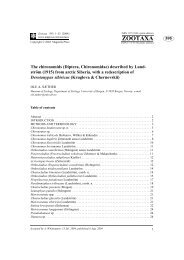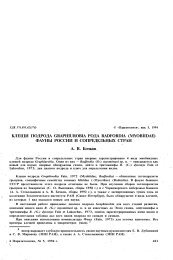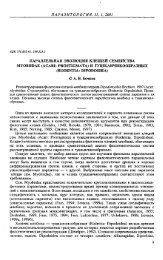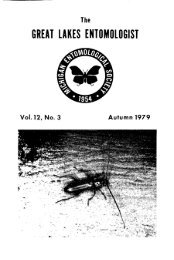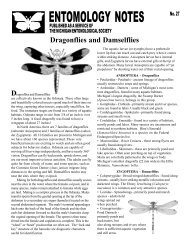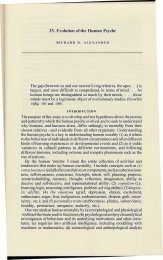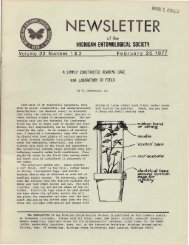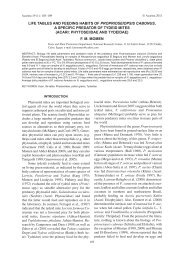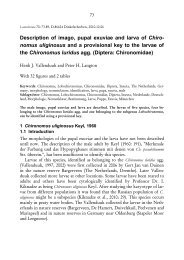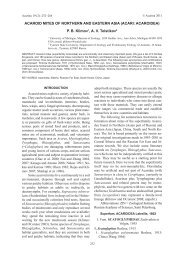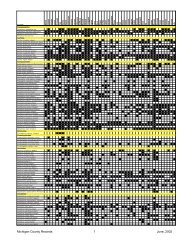Neglected and new characters of identifying Tanpodinae larvae
Neglected and new characters of identifying Tanpodinae larvae
Neglected and new characters of identifying Tanpodinae larvae
Create successful ePaper yourself
Turn your PDF publications into a flip-book with our unique Google optimized e-Paper software.
83<br />
Lauterbornia 68: 83-93, D-86424 Dinkelscherben, 2009-12-17<br />
<strong>Neglected</strong> <strong>and</strong> <strong>new</strong> <strong>characters</strong> in Chironomidae: Tanypodinae<br />
(<strong>larvae</strong>)<br />
Henk Vallenduuk <strong>and</strong> Andrea Lipinski<br />
With 17 figures<br />
Keywords: Tanypodinae, Chironomidae, Diptera, Insecta, morphology, identification, feature<br />
Schlagwörter: Tanypodinae, Chironomidae, Diptera, Insecta, Morphologie, Bestimmung,<br />
Merkmal<br />
In 2007 Henk Moller-Pillot <strong>and</strong> Henk Vallenduuk published a key to the <strong>larvae</strong> <strong>of</strong> the Tanypodinae<br />
(Diptera: Chironomidae). With untill then neglected <strong>and</strong> some <strong>new</strong> <strong>characters</strong> used<br />
in a <strong>new</strong> key the identification <strong>of</strong> the <strong>larvae</strong> will be very easy <strong>and</strong> reliable. Examples <strong>of</strong> these<br />
<strong>characters</strong> are shown <strong>and</strong> discussed in the following.<br />
1 Introduction<br />
For a long time specialists <strong>and</strong> hobbyists have been publishing keys to identify<br />
insects. They study the material to find details in features that can be used to<br />
separate species, in many cases using the <strong>characters</strong> described in previous publications.<br />
However, the recently published key to the <strong>larvae</strong> <strong>of</strong> the Tanypodinae<br />
(Diptera: Chironomidae) by Vallenduuk <strong>and</strong> Moller Pillot (2007) incorporates<br />
<strong>new</strong> <strong>characters</strong> that make identification <strong>of</strong> the <strong>larvae</strong> easy <strong>and</strong> reliable.<br />
When studying the <strong>larvae</strong> <strong>of</strong> the Tanypodinae during the preparation <strong>of</strong> this<br />
book, Vallenduuk discovered that some <strong>characters</strong> which can be used to separate<br />
species had previously been neglected or had never been examined before.<br />
The method for finding good <strong>characters</strong> described in this paper can be <strong>of</strong><br />
help to those who want to develop a key. The figures referred to in this paper<br />
are those in Vallenduuk <strong>and</strong> Moller Pillot (2007). We recommend first looking<br />
for macroscopic <strong>characters</strong>. We believe that by comparing species differences<br />
such <strong>characters</strong> can be found in any group <strong>of</strong> macr<strong>of</strong>auna.<br />
2 The <strong>characters</strong> in Tanypodinae<br />
To bring uniformity to morphological terminology, Saether (1980) published<br />
an illustrated glossary <strong>of</strong> chironomids showing the <strong>characters</strong> in imagos, pupae<br />
<strong>and</strong> <strong>larvae</strong>. This terminology is the current st<strong>and</strong>ard. Most <strong>of</strong> the <strong>characters</strong><br />
used in keys to the <strong>larvae</strong> are features <strong>of</strong> the head, where many good <strong>characters</strong><br />
can be found.
84<br />
Another good feature is the setation <strong>of</strong> the thorax <strong>and</strong> abdomen. However, because<br />
setae can be broken <strong>of</strong>f, the use <strong>of</strong> this feature in keys can cause problems<br />
<strong>and</strong> it is probably seldom used. We only use this character when the setation is<br />
very typically <strong>and</strong> very reliable. Rieradevall & Brooks (2001) studied the setation<br />
<strong>of</strong> the head capsule. These setae are hard to detect <strong>and</strong> so we decided not<br />
to use this feature.<br />
2.1 Studying <strong>characters</strong><br />
When first studying the <strong>characters</strong> <strong>of</strong> <strong>larvae</strong> we recommend to use only <strong>larvae</strong><br />
which have been identified with certainty. The following methods for obtaining<br />
reliably identified material are listed in order <strong>of</strong> decreasing certainty:<br />
1. Rearing one larva to imago in a culture box (Fig. 1), or use slides made by<br />
specialists, on which all instars <strong>of</strong> one specimen have been mounted after rearing<br />
to imago.<br />
2. Having associated <strong>larvae</strong> after <strong>identifying</strong> the pupal exuviae <strong>and</strong>/or imagos<br />
after they are caught in an emergence trap (Fig. 2). In this case it is possible that<br />
if one species is reared the remaining <strong>larvae</strong> can belong to another species.<br />
More than one species can occur at the same moment at the same site.<br />
3. Collecting <strong>larvae</strong> at the same location where pupae or pupal exuviae are<br />
found. In this case the <strong>larvae</strong> collected at the same location may not belong to<br />
the same species as the pupal exuviae.<br />
1 2
Fig. 1: Culture box for rearing Chironomidae <strong>larvae</strong>. Fig. 2: Emergence trap<br />
85<br />
Using reliable material, the first author started looking for <strong>new</strong> <strong>characters</strong><br />
simply by comparing all species or groups <strong>of</strong> sibling species. He used his own<br />
material, obtained using method 1 above, <strong>and</strong> material given by Susanne<br />
Michiels (certified biologist, Emmendingen/Germany) <strong>and</strong> Marion Kotrba (Zoologisches<br />
Staatsmuseum München). He first looked for <strong>characters</strong> which can<br />
easily be seen with a dissectingr microscope at a magnification 10–60x. Once<br />
good (known <strong>and</strong> <strong>new</strong>) <strong>characters</strong> for <strong>identifying</strong> the <strong>larvae</strong> had been found,<br />
other unidentified <strong>larvae</strong> could be studied to check the <strong>characters</strong>.<br />
2.2 <strong>Neglected</strong> <strong>characters</strong><br />
Postoccipital region<br />
Features on this part <strong>of</strong> the head have never before been used in keys. The<br />
"tentorial line" <strong>and</strong> "tentorial pit" differ very much. Wide headed (Fig. 3) <strong>and</strong><br />
elongate headed (Fig. 4) <strong>larvae</strong> can easily be separated by the presence <strong>and</strong> the<br />
shape <strong>of</strong> this line <strong>and</strong> pit.<br />
Fig. 3: Tanypus punctipennis. Wide headed Tanypodinae larva, head ventrally.<br />
Sclerotized tentorial lines, laterally arising anteriorly from the postoccipital margin<br />
<strong>and</strong> ending in tentorial pits (arrow)
86<br />
Fig. 4: Paramerina cingulata. Elongate headed Tanypodinae larva, postoccipital region<br />
dorsally with tentorial lines <strong>and</strong> tentorial pits (arrow). Tentorial lines <strong>and</strong> pits are<br />
hardly visible in elongate headed <strong>larvae</strong>, only when using a microscope they are<br />
visible!<br />
Fig. 5: Procladius. Postoccipital region ventrally with tentorial lines (arrow)<br />
In wide headed <strong>larvae</strong>, for example, the genera Procladius <strong>and</strong> Psectrotanypus look<br />
very similar in general view. But when comparing the tentorial lines <strong>and</strong> pits it<br />
is very easy to separate these genera. In Procladius (Fig. 5) the tentorial lines are<br />
obvious, but in Psectrotanypus they seem to be absent (Fig. 6). In Anatopynia
87<br />
plumipes the tentorial line is unique because it does not run to the postoccipital<br />
margin <strong>and</strong> creates a second line (Fig. 7).<br />
The postoccipital margin has some hooks ventrally only in Ablabesmyia <strong>and</strong><br />
Zavrelimyia (Fig. 8).<br />
Fig. 6: Psectrotanypus varius. Postoccipital region, tentorial lines not clearly visible<br />
Fig. 7: Anatopynia plumipes. Head ventrally. Tentorial lines do not arise from the<br />
postoccipital margin, they create second lines
88<br />
Fig. 8: Ablabesmyia. Postoccipital margin ventrally with hooks<br />
2.3 New <strong>characters</strong><br />
Setation<br />
The subfamily <strong>of</strong> the Tanypodinae is divided into two groups: wide headed <strong>and</strong><br />
elongate headed species. These groups can be separated by the presence or absence<br />
<strong>of</strong> a lateral fringe <strong>of</strong> setae on the abdomen, which is usually used in previous<br />
keys. Other authors have found unique setation in some species. Goddeeris<br />
(personal communication) states that the setation <strong>of</strong> the prothoracic is unique<br />
in Psectrotanypus varius (Fig. 9). Only Natarsia has four lateral setae on each abdominal<br />
segment (Fig. 10).<br />
The setation also differs in other species: three species <strong>of</strong> Macropelopia can be<br />
separated rather easily by the configuration <strong>of</strong> lateral setae on the mesothorax<br />
(Fig. 11, 12) or on abdominal segment VII. The thickness <strong>of</strong> the Ov-setae differs<br />
between species groups <strong>and</strong> between species (Fig. 13, 14). Only the <strong>larvae</strong> <strong>of</strong> the<br />
Conchapelopia aggregate have long dorsal setae (Fig. 15). However, setae can be<br />
broken <strong>of</strong>f, particularly if the material is treated roughly or if it is very old. If<br />
the samples are treated with care, setation is a reliable character for separating<br />
certain species.
Fig. 9: Psectrotanypus varius. Thorax<br />
ventrally, lateral setation<br />
89<br />
Fig. 10: Natarsia. Abdominal segment,<br />
lateral setae<br />
Fig. 11: Macropelopia adaucta. Fig. 12: Macropelopia nebulosa.<br />
Thorax, lateral setae Thorax, lateral setae
90<br />
Fig. 13: Schineriella schineri. Postoccipital region, ventrally. Ov-setae at the anterior<br />
margin <strong>of</strong> the prothorax (only left tentorial line drawn)<br />
Fig. 14: Conchapelopia. Postoccipital region, ventrally. Ov-setae (only left seta is<br />
drawn)<br />
Fig. 15: Conchapelopia. Abdomen with long dorsal setae
91<br />
Pigmentation<br />
Pigmentation is a very reliable character for separating Tanypus punctipennus from<br />
the other two species in the genus. Only this species has a characteristic pigmentation<br />
between both tentorial lines (Fig. 3).<br />
Shape <strong>of</strong> the head<br />
The shape <strong>of</strong> the head is different in many species, especially in elongate headed<br />
species. This character was not used in the key due to time constraints, but the<br />
book contains tables with these head shapes (Fig. 16) (Vallenduuk & Moller<br />
Pillot 2007: 64-65.<br />
Conchapelopia aggregate<br />
The Conchapelopia aggregate consists <strong>of</strong> species which are difficult to identify.<br />
The features "maxillary palp b seta" <strong>and</strong> "pseudoradula" are given in Fittkau &<br />
Roback (1983). Vallenduuk made drawings <strong>of</strong> the shape <strong>of</strong> the claws <strong>of</strong> the anterior<br />
parapods. All these <strong>characters</strong> can only be seen with a microscope at high<br />
magnification (400x), <strong>and</strong> so identification to the genera or species will be not<br />
always be possible.<br />
Fig. 16: Tanypodinae. Elongate-headed <strong>larvae</strong>, shape <strong>of</strong> some heads
92<br />
2.4 Additional information about the morphology<br />
The key in Vallenduuk & Moller Pillot (2007) contains distinguishing <strong>characters</strong><br />
to identify individual species. The book also contains additional information<br />
on <strong>characters</strong>:<br />
1. An overview <strong>of</strong> thoracic horns in prepupae (thanks to Dr Peter Langton).<br />
2. Comments on the key, including some additional <strong>and</strong> relevant morphological<br />
<strong>characters</strong> <strong>and</strong> explanatory notes on the key for every species.<br />
3. Tables <strong>of</strong> measurements <strong>and</strong> other features <strong>of</strong> <strong>characters</strong> for all species. Many<br />
species can be identified easily using the combination <strong>of</strong> <strong>characters</strong> given in<br />
these tables.<br />
4. Figures showing the shape <strong>of</strong> the head <strong>and</strong> the postoccipital region for many<br />
genera <strong>and</strong> species (Fig. 17).<br />
Fig. 17: Tanypodinae. Postoccipital region in some elongate headed <strong>larvae</strong>, ventrally<br />
This key to the Tanypodinae <strong>larvae</strong> is the first one in a series <strong>of</strong> books on the<br />
Chironomidae to be published over the coming years. Whereas keys generally<br />
only describe the morphological <strong>characters</strong> used in the key itself, the authors<br />
have published all the information that could be gathered. Besides a key, the<br />
book contains additional information about the general ecology <strong>of</strong> Chironomidae<br />
<strong>and</strong> the morphology, systematics, biology <strong>and</strong> ecology <strong>of</strong> the Tanypodinae.
93<br />
References<br />
Fittkau, E. J. & S. S. Roback (1983): The <strong>larvae</strong> <strong>of</strong> Tanypodinae (Diptera: Chironomidae) <strong>of</strong> the<br />
Holarctic region-Keys <strong>and</strong> diagnosis.- In: Wiederholm, T. (editor): Entomologica Sc<strong>and</strong>inavica ,<br />
Supplement 19: 33-110, Copenhagen<br />
Langton, P. H. (1991): A key to pupal exuviae <strong>of</strong> west Palearctic Chironomidae. – Private publication<br />
Rieradevall, M. & S. J. Brooks (2001): An identification guide to subfossil Tanypodinae <strong>larvae</strong> Insecta:<br />
Diptera: Chironomidae) based on cephalic setation.- Journal <strong>of</strong> Palaeolimnology, 25: 81-<br />
99, Dordrecht<br />
Saether, O. A., 1980. Glossary <strong>of</strong> chironomid morphology terminology (Diptera: Chironomidae).-<br />
Entomologica Sc<strong>and</strong>inavica, Supplement 14: 1-51, Copenhagen<br />
Vallenduuk, H .J. & H. K. M.Moller Pillot (2007): Chironomidae <strong>larvae</strong> Vol. I: General ecology<br />
<strong>and</strong> Tanypodinae.- 144 pp., (KNNV Publishing) Zeist<br />
Address <strong>of</strong> the authors: Henk Vallenduuk, Spoorven 431, NL-5464 PA Veghel, The Netherl<strong>and</strong>s,<br />
email: buro.vallenduuk@home.nl<br />
Dipl.-Ing. Andrea Lipinski, Jacobistrasse 19, D-26121 Oldenburg, drealipinski@gmx.de<br />
Received: 2009-08-28



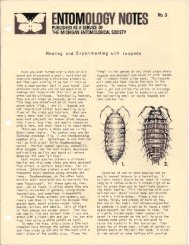
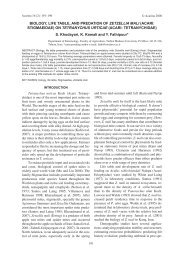
![Williamsonia 1-1 [v4.0] (DR) - Insect Division - University of Michigan](https://img.yumpu.com/18248489/1/190x245/williamsonia-1-1-v40-dr-insect-division-university-of-michigan.jpg?quality=85)
